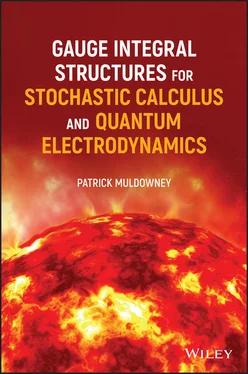The book can be read as a collection of standalone accounts of topics which are suggested, or introduced, or touched upon, in [MTRV]. Equally, it can be read as a supplement to [MTRV], developing the ideas of stochastic sums and path integrals which were introduced in [MTRV].
The formal theorem‐proof layout is avoided in favour of concrete illustrations. In almost cases, the relevant theorems and proofs are cited from [MTRV]. But exceptions are made for a few fundamental results such as analogues or versions of theorems 4, 62, 64, and 65 of [MTRV]. The theorem‐proof format is applied in these few exceptional cases.
Also, some of the illustrative examples are “thought experiments”, exercises of imagination intended to clarify, not finance or physics as such, but certain mathematical issues which arise in these subjects.
Notes and additional material for the book can be found at:  " >
" >
 " >
" >  " >
" > https://sites.google.com/site/StieltjesComplete/
—also used to record typos, errors, and corrections; and cited as [ website] in this book.
Sincere thanks to colleagues and readers who help by sharing their thoughts via:  " >
" > stieltjes.complete.integral@gmail.com
1 1 In [MTRV], usually denotes , with denoting . Also, is used in [MTRV] to denote , or .
The gauge integral is a version of the Riemann integral, with much improved convergence properties. Convergence properties are conditions which ensure integrability of a function; in particular, integrability of the limit of a convergent sequence of integrable functions, with integral of the limit equal to the limit of the integrals—the limit theorems.
Another notable property of the gauge integral in one dimension is that, if a function possesses a corresponding derivative function, the derivative is integrable, with indefinite integral equal to the original function. Curiously, this “schooldays meaning”—integration as the reverse of differentiation—does not hold universally for the more widely used integration systems. See Section 10.2 of Chapter 10, which provides an overview of this subject.
The gauge integral (called ‐complete integral in [MTRV], and in this book) is non‐absolute. Other kinds of integration, such as Lebesgue's or Riemann's, have restrictive requirements of absolute convergence. But existence of ‐complete integrals requires only that the Riemann sum approximations converge non‐absolutely to the value of the integral; and this is central to the present book.
In [MTRV], instead of the more familiar term gauge integral, the term ‐complete integral (as in Riemann‐complete) is found to be helpful. 2This is because there are a great many different integration techniques—Riemann, Lebesgue, Stieltjes, Burkill, and others—which are used in different situations; most of which can be subsumed or adapted into a gauge integral system. But to assign indiscriminately the blanket designation “gauge integral” to each of the adapted versions is to ignore, firstly, their considerable difference in usages and origins; and, secondly, the fact that “gauge integral” has become practically a synonym for the one‐dimensional generalized Riemann (or Riemann‐complete) integral—also known as the Kurzweil‐Henstock integral.
Also, the general or abstract integral—called Henstock integral in chapter 4 of [MTRV]—has diverged historically from the more mainstream gauge or Kurzweil integration which has “integral‐as‐antiderivative” as its driving force. This aspect of the subject is touched on in Chapter 10below.
The integral‐as‐antiderivative feature of one‐dimensional Riemann‐complete integration was mentioned in passing in Henstock's 1962–63 exposition [70], which concentrated on other aspects of integration (such as limit theorems 3and Fubini's theorem).
As a student Henstock was attracted to the theory of divergent series. When in 1944 he applied to Paul Dienes to do research in this subject, he was steered towards integration theory [11]; and his subsequent work often focussed on the margins between divergence and convergence. 4
The gauge idea made its first appearance in Henstock's published work in [69], in a scenario of extreme divergence in which the gauge method is “tested to destruction” in its first public outing. (This counter‐example is rehearsed in pages 178–181 of [MTRV], section 4.14, Non‐Integrable Functions . See also Example 13 below.) There is no mention in his 1955 paper [69] of the reversal of differentiation which many students of the subject have found so useful. Nor does it touch on the notion of random variation in which theories of integration and measure play a central role, and where integral convergence is much more important than differentiation. 5
The emphasis on convergence is maintained in the present book, which can be read as a stand‐alone, self‐contained, or self‐explanatory volume expanding on certain themes in [MTRV]. Like [MTRV] this book aspires to simplicity and transparency. No prior knowledge of the subject matter is assumed, and simple numerical examples set the scene. There is a degree of repetitiveness which may be tedious for experts. But experts can cope with that; more consideration is owed to less experienced readers.
For reasons demonstrated in [MTRV], and amply confirmed in the present volume, non‐absolute convergence is one of the characteristics which, in comparison with other methods, makes the gauge (or ‐complete) integrals suitable for the two main themes of this book: stochastic calculus and Feynman integration.
Stochastic calculus is the branch of the theory of stochastic processes which deals with stochastic integrals, also known as stochastic differential equations. A landmark result is Itô’s lemma, or Itô’s formula.
Stochastic integration is part of the mathematical theory of probability or random variation. Broadly speaking, quantities or variables are randomor non‐deterministicif they can assume various unpredictable values; and they are non‐randomor deterministicif they can take only definite known values.
Classically, stochastic integrals are constructed by means of a procedure involving weak limits. The purpose of this book is two‐fold:
To treat stochastic integrals as actual integrals; so that the limit process which defines a stochastic integral is essentially the same as the limit of Riemann sums which defines the more familiar kinds of integral.
To provide an alternative theory of stochastic sums which achieves the same purposes as stochastic integrals, but in a simpler way.
Mathematically, integration is more complicated and more sophisticated than summation (or addition) of a finite number of terms. It is demonstrated that stochastic sums can achieve the same (or better) results as stochastic integrals do. In the theory of stochastic processes, stochastic sums can replace stochastic integrals.
Examples of concrete nature are used to illustrate aspects of stochastic integration and stochastic summation, starting with relatively elementary ideas about finite numbers of things or events, in which there is no difference between summation and integration. A basic calculation of financial mathematics (growth of portfolio value) is used as a reference concept, as a vehicle, and as an aid to intuition and motivation.
Читать дальше

 " >
" > " >
" >  " >
" >  " >
" > 










